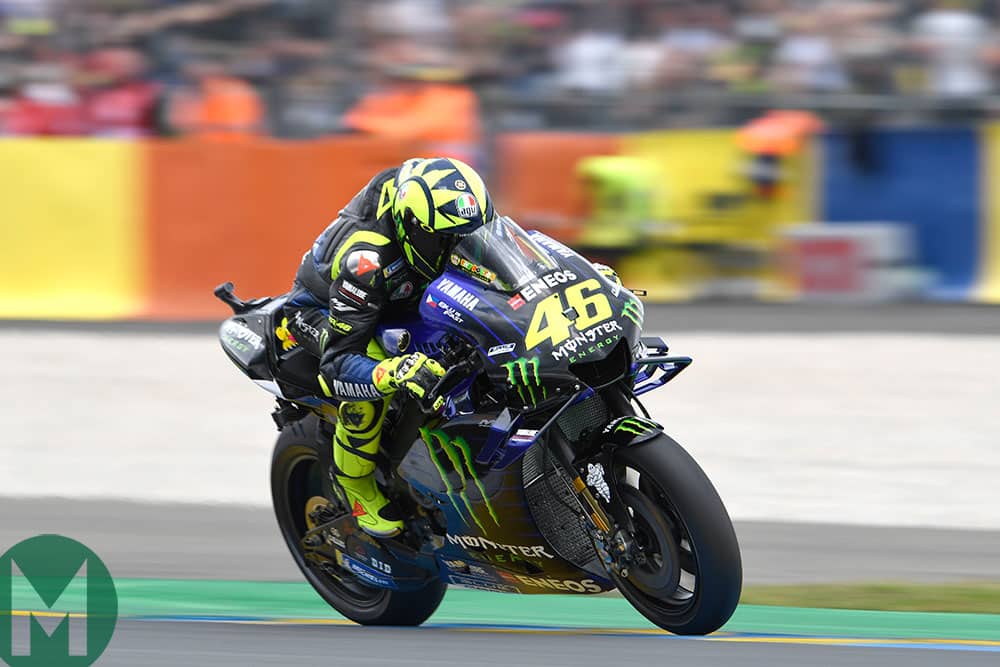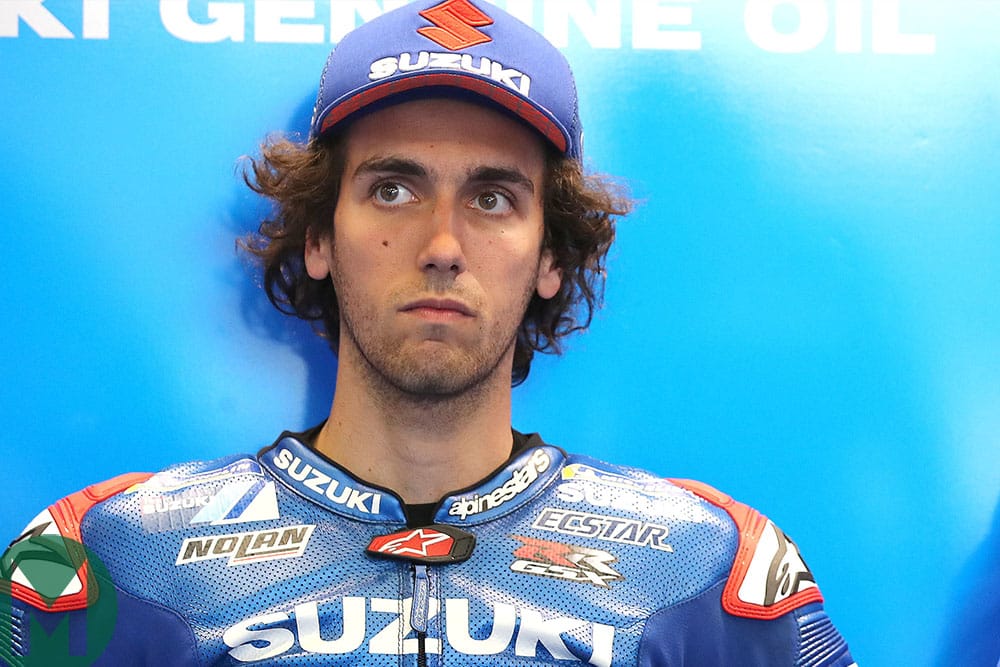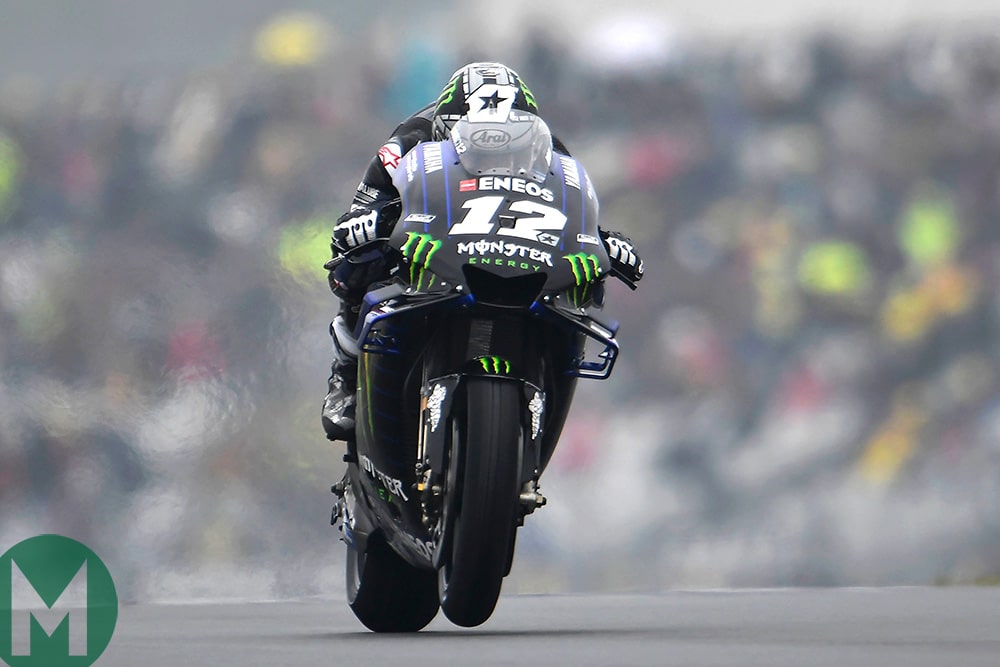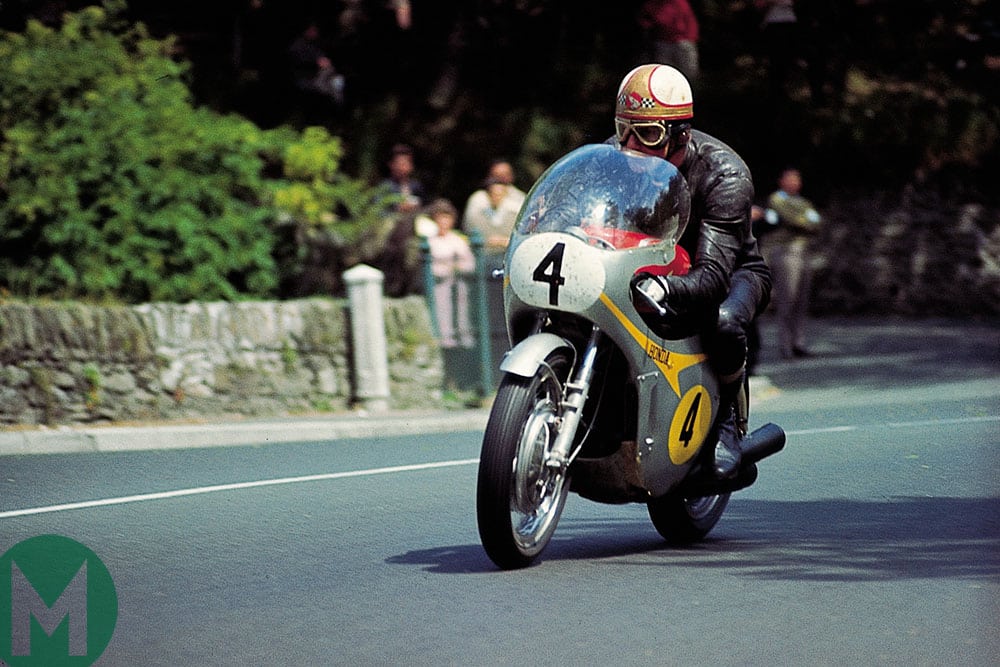
Was Martín's title defence the worst in MotoGP history?
Reigning MotoGP champion Jorge Martín completed the 2025 season in 21st place, after a title defence destroyed by multiple injuries
MotoGP Mutterings, part 2: Rossi’s lack of pace doesn’t bode well for his home race, plus why the grippy Le Mans tarmac may be behind the high crash count and weak performance from Álex Rins

Rossi’s Yamaha continues to lack top-speed pace Motorsport Images/Gold and Goose
Mugello next – home to MotoGP’s longest straight and the biggest army of Valentino Rossi fans you’ll ever see. Rossi won seven consecutive premier-class victories at the track, from 2002 to 2008, and will be desperate to climb the podium next week, as he did last year.
But there’s a problem. His Yamaha is further off the top-speed pace than it was last season, which will most likely cause him serious problems at his home race.
“It looks like we suffer very much on the straights this year,” said Rossi after battling with the Ducatis of Danilo Petrucci and Jack Miller at Le Mans. “On top speed we lose a lot, so it’s difficult, especially in the race when I was fighting with the Ducatis and they were a lot faster on the straights, which made it difficult to manage overtakes.”
The biggest problem for Yamaha is that its engineers can do next to nothing to coax more speed from its 2019 YZR-M1 because all engines are sealed on the eve of the first race.
“I don’t think we can improve a lot this year,” Rossi added. “The other manufacturers have made another step on the straights, especially Honda, and now the difference is very big. This is the situation, so we have to give our maximum to fight for the podium.
“Otherwise this year’s bike is good to ride. We have improved tyre life with a few different things and it looks like I’m good in braking. Our speed will depend very much on track layout. The truth is that since 2004 the Yamaha has never been fantastic on the straights but this year we lose very much.
More: The making of Valentino Rossi
In fact, Yamaha has never built the fastest 500s or MotoGP bikes. Historically its riders have won races using the user-friendliness and corner-speed capabilities of their bikes. Rossi won his last victory at Mugello despite a 2mph/3.2kmh top-speed handicap.
However, MotoGP is so close now that even a slight lack of straight-line performance has a high cost. And Rossi’s 2019 Yamaha gives away significantly more than it did in 2008.
The best place to compare the speed of the 2019 MotoGP bikes is COTA, which includes MotoGP’s longest straight, where riders accelerate from first gear to around 217mph/350kmh.
Last year at COTA, Rossi was 3.42mph/5.5kmh slower through the speed trap than the fastest bike. This year that handicap increased to 4.47mph/7.2kmh. When a rider lacks that much top speed he will find very difficult to make a pass on the brakes and he will try to compensate for that deficit by entering corners more aggressively, so his front tyre will degrade sooner.
At Le Mans Rossi sat at the very bottom of the top-speed charts – 6.7mph/10.8kmh behind the fastest bike – although this doesn’t necessarily reflect machine performance because riders are already setting up for the super-fast turn one when they go through the Le Mans speed trap. However, Rossi raced with Yamaha’s double-wing aero for the first time and suggested that although this aerodynamic package helps acceleration by reducing wheelies it may create too much drag at high speeds.
Once again, Le Mans was a crash fest, with 90 crashes over the three days. The crash counts at the first four rounds were 51 at Losail, 44 at Termas, 42 at COTA and 57 at Jerez, so why so many tumbles at Le Mans? Rain did a play a part this time, but in fact, during last year’s fully dry Le Mans weekend there were 109 accidents; an all-time record for a grand prix unaffected by rain.
“Le Mans is a very stop-and-go track, so we are all trying to brake later and later,” explained Aprilia’s Aleix Espargaró. “The track is also very grippy. When you are riding a low-grip track, you don’t really push on the brakes, but if the grip is high you push more and more every time because you feel really good, but then you reach the limit.”
Espargaró finished 12th on Sunday and pinpointed the RS-GP’s engine character and electronics set-up as the main culprits;
“It’s the same problem all season – I lose a lot of time in acceleration because our traction is very bad,” he added. “I think this problem comes from the engine and the electronics, not from the chassis, because we have a really good chassis. I’m strong on the brakes but we have no acceleration because of our engine power delivery and the electronics – our traction control doesn’t work at all.”

Motorsport Images/Gold and Goose
The Le Mans surface and layout also caused problems for Suzuki’s title contender Álex Rins and rookie team-mate Joan Mir.
The Suzuki GSX-RR’s greatest strength has always been its corner-entry speed, especially turning performance when the rider releases the brake. Somehow this disappeared at Le Mans, leaving Rins 19th in qualifying and tenth in the race.
“We were missing something in the first part of the corner, from the moment I released the brakes,” Rins explained after his worst result since Brno last August. “If I tried to use more corner speed I lost the front. Last year we had the same problem here and more or less the bike is the same, so we need to resolves this. Maybe it was the low temperatures or maybe the types of corner.”
Or perhaps the grippy (but tricky) Le Mans asphalt masked the corner-entry issues of the other bikes without giving the Suzuki an equivalent improvement?
More: How I ride: Álex Rins
Mir had an even worse weekend than Rins. He doubled his season crash tally with four tumbles, including two in morning warm-up and two at Turn Three, the first part of the chicane at the end of the start/finish straight. This left-hander accounted for 30 of the 90 crashes during the weekend. It’s always been an accident blackspot because it follows the long front straight, so the front tyre cools down too much and fails to grip as riders flick the bike into the corner.
“All weekend it’s been really difficult to warm up the front tyre,” explained Mir, whose strangest crash came at the start of the warm-up lap when both the Spaniard and Karel Abraham locked the front and fell while braking for Turn Three. “I braked really early and locked the front with the bike completely straight and with almost no pressure on the brakes. I haven’t crashed once this weekend while pushing hard.”
There were several theories about the Mir/Abraham incident – most likely a combination of cold tyres and cold brakes or something on the track.

Motorsport Images/Gold and Goose
There is probably no one in the MotoGP paddock who’s more confused and more confusing than Maverick Viñales.
His performance yoyos all over the place. One day he is convinced he has found the right way forward with bike settings and riding technique, then the next day he’s nowhere and he’s not sure why.
Two weeks after scoring his first podium of the year the Spaniard was fastest on day one at Le Mans and brimming with confidence.
“We made a step in FP4 at Jerez and again in the tests,” he said on Friday evening. “We changed the balance of the bike a little, so I can be more aggressive, which I like. I think with this speed and this feeling we can also be fast at other tracks. The feeling I have with the bike is more consistent from one session to the next, so I can focus on my riding and improving my riding.”
Saturday’s rain-affected qualifying was the start of Viñales’ Le Mans downfall. He was the slowest rider in Q2, which put him 11th on the grid. Then he crashed at Turn Three in the morning warm-up and after the start of the race, he quickly went back to 14th. Deep in the pack, he was taken out by Pecco Bagnaia on lap seven.
At the end of last season, Viñales started searching for a sports psychologist to help him keep cool and calm during race weekends. He has yet to find someone that can help him in this area.
Jorge Lorenzo’s progress at Honda could be slowed by MotoGP’s latest aerodynamics regulations.
The three-times MotoGP champ wants a reprofiled fairing to help improve his control of his RC213V. However, since the aerodynamics rules were tightened to reduce spending, each rider is only allowed one aerodynamics update per year, so Lorenzo will most likely have to wait until HRC is ready with its second aero package of 2019.
Lorenzo’s RC213V left, at Qatar GP with wide seat and fairing knee pads; right, at French GP with standard seat and no knee pads
At the start of this season Lorenzo had rubber kneepads fitted to each side of his fairings, so he could use his knees to support himself during braking. Perhaps this is the kind of thing he wants from a new fairing.
“We have a limitation because there’s something I want to do with the fairing,” he said at Le Mans, after finishing 11th. “If we can do this I think it will help me quite a bit, but we are limited by rules. It will take time before this new modification arrives, which I think will make me more feel more comfortable on the bike. Also, by then I will know more about the riding style required to take the maximum from the Honda.”
At Le Mans Lorenzo dispensed with his special seating arrangement, returning to a more standard set-up, presumably to help him sit more ‘in’ the bike than ‘on’ it. Ergonomics are more important to him than any other rider, because his riding technique is so precise. “This type of seat came from my time at Yamaha,” he added. “I also used it at Ducati, but with this bike it doesn’t work, the standard Honda seat is better. I’m trying things that give me a benefit – comfort, safety in corner entry – and every small step is like a victory. It’s going to be a long process.”

Mike Hailwood scores Honda’s sixth 500cc win at the 1967 Isle of Man Honda
Márquez’s Le Mans victory was Honda’s 300th premier-class success since the factory won first time out at Hockenheim in 1966, when Jim Redman and the RC181 four-cylinder 500cc four-stroke left Giacomo Agostini’s MV Agusta trailing.
During the last five decades or so Honda has used seven different types of premier-class machine. The inline-four RC181 contested the 1966 and 1967 500cc championships. The bike won the constructors title in 1966 and the next year, with Mike Hailwood on board, came within one dropped valve of winning Honda’s first 500cc riders title.
Honda stayed out of grand prix racing for the next 12 seasons, returning at the end of 1979 with the NR500 V4 four-stroke. By then the two-stroke had entirely taken over GP racing, essentially because it fires every crankshaft revolution, while the four-stroke makes its power every second revolution. Honda therefore believed it could beat the two-strokes by building a four-stroke that revved twice as high: 22,000rpm against the 11,000rpm of the Suzuki and Yamaha two-strokes. The NR500 had oval pistons, with eight valves, two sparkplugs and two conrods per cylinder, so it worked a bit like a V8. But it was never fast enough to win a race, let alone the world title.
More: Highsiding into history
In 1982 Honda finally went with the flow, creating the three-cylinder, reed-valve NS500 two-stroke. Honda engineers had noted that 350cc lap times were getting closer and closer to 500cc lap times, so they built a small, manoeuvrable triple that could beat the more powerful but less manageable four-cylinder Suzuki and Yamahas. In 1983 Freddie Spencer took the championship with the NS, making Soichiro Honda a very happy man by finally conquering motorcycling’s highest peak.
But by the end of 1983 the NS was already struggling against Yamaha’s V4, which finally had the handling to match its horsepower. Thus Honda built its own V4, the NSR500, for 1984. The NSR didn’t start out right, because HRC engineers were still into trying radical solutions. They fixed the fuel tank under the engine, with the idea of lowering the centre of gravity. This works well in car racing, but not in motorcycle racing.
The second NSR500, with the fuel tank back where it belongs, won the 1985 world title, with Spencer, and subsequent iterations won a further eight riders titles, with Wayne Gardner, Eddie Lawson, Mick Doohan, Alex Crivillé and Valentino Rossi. At Barcelona in 1996 Carlos Checa won Honda’s 100th 500cc victory on this NSR500. There is no doubt that the NSR is the greatest 500 of all time.
But its successor, the RC211V MotoGP bike, was even greater. While the other factories mostly fitted 990cc four-stroke engines into revised 500 chassis for the new MotoGP era, Honda created a miracle machine. The RC211V was a giant leap forward in engine and chassis design. No wonder it won 48 MotoGP races in five seasons, including Honda’s 200th premier-class success at Assen in 2006, with Nicky Hayden on board.
For every up, there is a down. Honda’s machine for the new 800cc era, starting in 2007, was the RC212V. The V4 won just two races in its first two seasons, while HRC engineers tried everything to make the bike handle right, including carbon-fibre-reinforced frames. Finally, HRC found the right road with the RC212V and in 2011 Casey Stoner rode the bike to the championship. The current RC213V, first raced in 2012, was based on the RC212V. The combination of a 270-horsepower 1000cc engine and a short, agile chassis makes the bike a challenge to ride unless the rider is prepared to grab the bull by the horns. Márquez has won 47 races on the RC213V in five and a bit seasons, an astonishing achievement. Dani Pedrosa won 16 races on the bike, Jack Miller one and Cal Crutchlow has so far scored three victories on his RC213Vs.
The next most successful premier-class manufacturers are Yamaha (227 wins), MV Agusta (139), Suzuki (92), Ducati (47), Gilera (35) and Norton (21).

Reigning MotoGP champion Jorge Martín completed the 2025 season in 21st place, after a title defence destroyed by multiple injuries

KTM’s Pedro Acosta was one of MotoGP's stars in 2025 aboard his steadily improving RC16. KTM reveals how it went backwards to go forwards, why the purpose of a mass damper is to prevent all the resonances on a MotoGP bike having a party together and why KTM wants them banned

How Ducati’s failure to communicate the reasons behind its 2025 bike troubles created innumerable online conspiracy theories and spoiled what was a glorious season, with Marc Márquez at least

Dorna, MotoGP Race Direction and IRTA say the leg wings fitted to Aprilia's RS-GP are a safety concern, so they could be banned with immediate effect